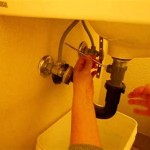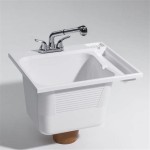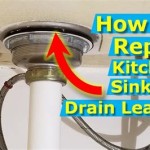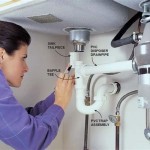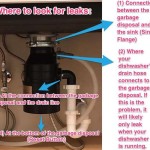How To Clean A Smelly Bathroom Sink Drain
A persistent bad odor emanating from a bathroom sink drain is a common household problem, often indicating a buildup of organic matter, soap scum, hair, and other debris within the drainpipe. This accumulation fosters the growth of bacteria and mold, which are the primary culprits behind the unpleasant smell. Ignoring the issue can lead to more severe plumbing problems, including clogs that impede water flow and require professional intervention. Therefore, proactively addressing the source of the odor through regular cleaning is essential for maintaining a hygienic and functional bathroom sink.
The effectiveness of any drain cleaning method hinges on understanding the anatomy of the drain itself. Familiarizing oneself with the sink’s components, particularly the P-trap, is crucial. The P-trap is a U-shaped section of pipe located beneath the sink that holds a small amount of water, creating a seal that prevents sewer gases from entering the bathroom. This water seal is a critical feature of the plumbing system, and improper maintenance or damage to the P-trap can contribute to persistent odors. Before attempting any cleaning procedure, it is advisable to consult the sink’s installation manual or a plumbing diagram to identify the location and configuration of the P-trap and other relevant components.
Numerous methods exist for cleaning a smelly bathroom sink drain, ranging from simple home remedies to more intensive approaches involving dismantling the drainpipe. The choice of method depends on the severity of the odor, the suspected cause of the problem, and the homeowner’s comfort level with plumbing tasks. It is generally recommended to start with the least invasive methods and gradually progress to more complex procedures if the initial efforts prove unsuccessful. Adhering to safety precautions, such as wearing gloves and eye protection, is paramount when handling cleaning agents and disassembling drain components.
Boiling Water Flush
One of the simplest and most environmentally friendly approaches to combatting drain odors is flushing the drain with boiling water. This method is particularly effective for melting away grease and soap scum that accumulate along the drainpipe walls. To execute this procedure, carefully boil a large pot of water, ensuring that it reaches a rolling boil. Slowly pour the boiling water down the drain, taking care to avoid splashing. The heat from the water will help to dislodge and dissolve the accumulated debris, which will then be flushed away with the water. It is advisable to repeat this process two to three times for optimal results. The boiling water helps to sanitize the pipes and eliminate odor-causing bacteria to a degree, though it may not remove solid obstructions.
Before using this method extensively, it is important to understand the composition of the sink and drain materials. Certain types of pipes, particularly older PVC pipes, may be vulnerable to damage from extreme heat. Repeated exposure to boiling water could potentially soften or warp these pipes, leading to leaks or even complete failure. If the sink or drain is made of a material that is susceptible to heat damage, it is prudent to explore alternative cleaning methods. Porcelain sinks are generally safe for boiling water applications, but caution is always advised. Furthermore, it's important to remove any standing water from the sink bowl before pouring the boiling water to prevent rapid temperature changes that could damage the sink's finish.
While the boiling water flush is a relatively safe and straightforward method, it may not be sufficient to address more stubborn clogs or odors. If the odor persists after several attempts, or if there is evidence of a significant blockage in the drainpipe, more intensive cleaning methods may be required. It is important to note that boiling water will not dissolve hair or other solid debris, so it should not be relied upon as a solution for removing physical obstructions.
Baking Soda and Vinegar Solution
A widely recognized and effective home remedy for cleaning drains is the use of a baking soda and vinegar solution. This method leverages the chemical reaction between these two common household ingredients to create a bubbling, cleaning action within the drainpipe. To prepare the solution, pour approximately one cup of baking soda down the drain, followed by one cup of white vinegar. The mixture will immediately begin to fizz and bubble, indicating the start of the cleaning process. Allow the solution to sit in the drain for at least 30 minutes, or preferably overnight, to maximize its effectiveness. During this time, the bubbling action will help to loosen and dissolve accumulated debris, while the vinegar’s acidity will help to neutralize odors.
After the waiting period, flush the drain with hot water for several minutes to remove the loosened debris and remaining baking soda and vinegar residue. The hot water will also help to further sanitize the drainpipe and eliminate any remaining odor-causing bacteria. If the odor persists after the initial treatment, repeat the process as needed. The baking soda and vinegar method is generally safe for most types of drainpipes, but it is always advisable to test the solution in an inconspicuous area first to ensure that it does not damage the material.
The chemical reaction between baking soda and vinegar produces carbon dioxide gas, which is the source of the bubbling action. This reaction is most effective when the baking soda and vinegar are used in equal proportions. Using an excessive amount of either ingredient will not necessarily improve the cleaning effectiveness and may even hinder the process. Additionally, it is important to avoid mixing baking soda and vinegar in a closed container, as the buildup of carbon dioxide gas could cause the container to explode. When pouring the solution down the drain, ensure that the bathroom is well-ventilated to prevent the accumulation of carbon dioxide gas.
This method works best when the drain is relatively free of standing water to allow maximum contact of the solution with the drain surfaces. You can use a plunger to remove any standing water before adding the baking soda and vinegar. The baking soda and vinegar method is most effective for removing soap scum and mineral deposits but it may not work well as a primary solution for hair clogs.
Disassembling and Cleaning the P-Trap
If the previous methods fail to eliminate the drain odor, it may be necessary to physically disassemble and clean the P-trap. This task requires a bit more plumbing knowledge and manual dexterity, but it is often the most effective way to remove stubborn blockages and thoroughly clean the drainpipe. Before starting, place a bucket or other container underneath the P-trap to catch any water or debris that may spill out during the disassembly process. Loosen the slip nuts that connect the P-trap to the drainpipe and the tailpiece (the pipe that connects the sink drain to the P-trap). Carefully remove the P-trap from the drain assembly and empty its contents into the bucket. Be prepared for an unpleasant smell.
Once the P-trap is removed, thoroughly clean it inside and out using a brush, such as an old toothbrush or a bottle brush, and a solution of warm, soapy water. Remove any accumulated debris, such as hair, soap scum, or grease. Rinse the P-trap thoroughly with clean water and inspect it for any signs of damage, such as cracks or corrosion. If any damage is detected, replace the P-trap with a new one. Similarly, inspect other drain components for corrosion or damage and replace those as needed. When reinstalling the P-trap, ensure that the slip nuts are tightened securely to prevent leaks, but avoid overtightening, which could damage the plastic fittings.
Disassembling the P-trap can also afford the opportunity to inspect the drain stub-out in the wall to ensure that isn't clogged. The drain stub out is the pipe in the wall that receives the drain assembly. You can use a small brush or a flexible tool to help clear out debris from this pipe. After cleaning, test the drain by running water to verify that there are no leaks and that the water flows freely. If leaks are detected, tighten the slip nuts further or replace the washers or compression rings within the fittings. If the problem persists, it may be necessary to consult a professional plumber to address the issue. A properly installed and maintained P-trap is essential for preventing sewer gases from entering the bathroom and maintaining a hygienic plumbing system.
It's important to remember the order and orientation of parts when disassembling the P-trap. Taking a picture before beginning disassembly can be a very helpful reference to ensure correct reassembly. When reassembling, ensure that the connections are properly aligned and that the washers are seated correctly within the slip nuts. Using Teflon tape on the threads of the fittings can help to create a watertight seal and prevent leaks.
In conclusion, maintaining a clean and odor-free bathroom sink drain requires a combination of proactive cleaning measures and timely intervention when problems arise. Regular flushing with boiling water or a baking soda and vinegar solution can help to prevent the accumulation of debris and the growth of odor-causing bacteria. When these methods prove insufficient, disassembling and cleaning the P-trap may be necessary to remove stubborn blockages and sanitize the drainpipe thoroughly. By adopting a consistent drain maintenance routine, homeowners can avoid unpleasant odors and costly plumbing repairs.

How To Clean A Stinky Sink Drain By Home Repair Tutor Youtube
:max_bytes(150000):strip_icc()/__opt__aboutcom__coeus__resources__content_migration__mnn__images__2018__08__sink_drain-351af8e441034f319fe07f00c091d8b6.jpg?strip=all)
How To Clean A Smelly Drain Naturally

4 Ways To Clean A Smelly Drain Wikihow

How To Clean A Smelly Sink Youtube

4 Ways To Clean A Smelly Drain Wikihow

How To Clean Stinky Drains Liquid Plumr

How Can I Help A Stinky Bathroom Sink Drain Cleaning More Youtube

How To Clean A Smelly Drain Rainbow Restoration

How To Clean A Smelly Sink Drain The Organization House

Why Your Drain Smells And How To Fix It Fast

